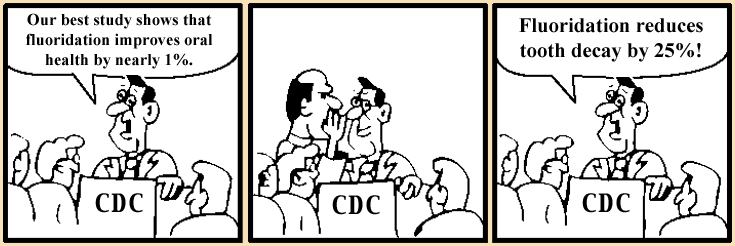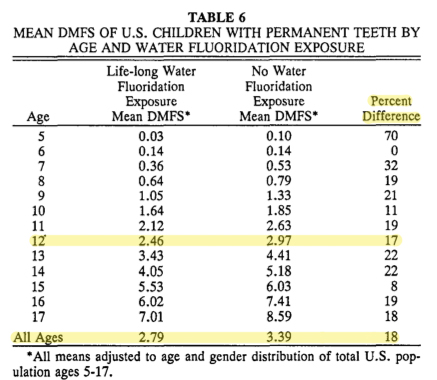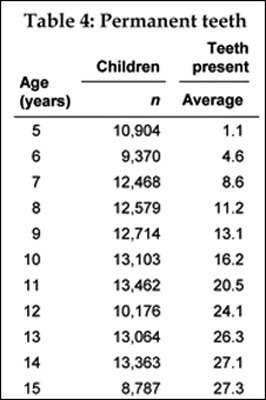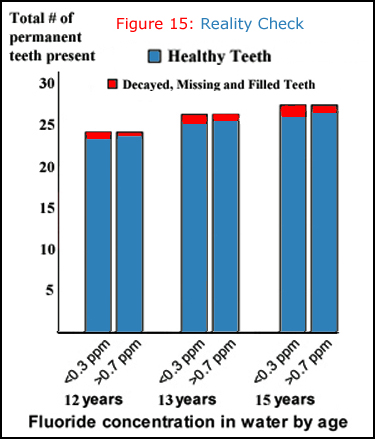|

Home Page
Known About Fluoride
Toothpaste Warning
Interferes with Brain
Fetal Vulnerability
Neurotoxicity
Genetic Factor
Needs to Be Known
Fetal Fluoride Intake
Fluoride Drugs
Amniotic Fluid
Bogus Sales Pitch
Statistical Spin
Oregon Deception
King Fluoride
Crazy Advice
Premature Birth
Infants Overdosed
Infant Mortality
Life Decay
Mental Fluorosis
Fluoride and
Neurodegeneration
End Fluoridation
Save $Billions
Know News
Prenatal Microbiome
Fluoride & Obesity
Vascular Dementia
Arterial Stiffness
2019 Studies
Fluoridation 'Science'
CDC's Irrationale
EPA's Pollutant
PHS's Debunkery
The Book
Contents
Author
|
Why We Should Not Buy the Fluoridation Sales Pitch,
the ad nauseam claim that:
"Fluoridation reduces tooth decay by 25%."

"25% less tooth decay" does not mean 25% better oral health.
An analogy (fiction):
|
"Vegetarian Diet Increases Weight Loss by 25%."
Would you believe this claim if you knew the facts:
With an average starting weight of 200 pounds, after 2 weeks:
• men on a non-vegetarian diet averaged 196 lb. – a loss of 4 pounds.
• men on a vegetarian diet averaged 195 lb. – a 1 pound difference.
Results: <1% difference (1÷195) in the average weights of the 2 groups,
but vegetarian promoters used a deceptive relative difference (1÷4) to claim:
"Vegetarian Diet Increases Weight Loss by 25%."
|
A reality (stranger than fiction):
|
With an average of 100 tooth surfaces, 12-year-olds:
• in unfluoridated cities averaged 97.03 healthy and 2.97 decayed tooth surfaces.
• in fluoridated cities averaged 97.54 healthy surfaces – a 0.51 surface difference.
Results: <1% difference (0.51÷97.03) in number of healthy tooth surfaces,
but fluoridation promoters used a deceptive relative difference (0.51÷2.97) to claim:
"17% less tooth decay in fluoridated 12-year-olds." (Table 6 below)
|
Knowing the facts, most people would not buy such a bogus claim of benefit.
But it's all they hear from the dental lobby, whose fluoridation sales pitch
is parroted and promoted by journalists in a contagious cascade of
endorsemental confusion masquerading as science.
|
The source of the deceptive sales pitch is the
US government's biggest and still its best study from 1990:
Recent Trends in Dental Caries in U.S. Children and the Effect of Water Fluoridation
This huge national epidemiological survey examined the health of permanent teeth in 39,000 children (aged 5-17 years) by counting DMFS: the number of Decayed, Missing, and Filled tooth Surfaces (i.e., past and present decay).
The result for "All Ages" (Table 6):
• Unfluoridated kids averaged 3.39 decayed tooth surfaces.
• Fluoridated kids averaged 2.79 decayed tooth surfaces.
a 0.6 surface difference.
 The government dentists divided 0.6 by 3.39 to claim: "Children who had always been exposed to community water fluoridation had mean DMFS scores about 18% lower than those who had never lived in fluoridated communities."
The government dentists divided 0.6 by 3.39 to claim: "Children who had always been exposed to community water fluoridation had mean DMFS scores about 18% lower than those who had never lived in fluoridated communities."
That 18% is an inaccurate "relative" difference is obvious. They could have used the same data and divided 0.6 by 2.79 to claim: Unfluoridated kids had 22% more tooth decay.
This survey is a prime example of the dental establishment's obsession with decayed teeth. They never mention healthy teeth or the total number of tooth surfaces. A 2002 Australian survey, however, did state the number of permanent teeth by age (Table 4 below), which allows us to expose the fluoride deception.
Table 6 shows that 7-year olds had a relative difference of 32% (0.17÷0.53) – even though their "absolute" difference was only a 0.17 of a one tooth surface.
Reality Check: 7-year olds average 8.6 permanent teeth. That's about 39 tooth surfaces, so there was only a 0.5% absolute difference (0.17÷39) in the number of healthy tooth surfaces in the fluoridated and unfluoridated kids.
As reported by Chemical & Engineering News: This national survey data "concludes that children who live in areas of the U.S. where the water supplies are fluoridated have tooth decay rates nearly identical with those who live in nonfluoridated areas."
But wait, there's more. The study's authors then
raised the benefit for all ages from 18% to 25%:
"When some of the 'background' effect of topical fluoride was controlled, this difference increased to 25%" – even though they said: "There was no way to control for either exposure to fluoride in dentrifices or incidental exposure to fluoride in the diet."
Sadly, most people unwittingly believe this bogus
decades-old sales pitch of 25% less tooth decay,
even highly educated and intelligent people
who would not believe similar claims.
(Did somebody say Innumeracy.)
|

|
"In medicine, numeracy is the ability to read medical literature, know statistics, and be able to translate the numbers into clinical relevance. From what I have observed, innumeracy is rampant in medicine."
Even in a highly educated, extremely intelligent, and motivated group such as physicians, innumeracy in medicine is common. "How many have the time to read past the sales pitch (i.e., the abstract)?"
Terms such as relative risk, absolute risk, statistical significance, or clinical significance are poorly understood by most physicians. This makes them vulnerable to inaccurate conclusions contained in abstracts and articles, and otherwise reach the wrong opinions.
"Most of the physicians don't understand how misleading relative risk can be... For example, in a popular Lipitor study, the 'benefit' of a statin over 4 years was reported as 28% reduction in events. This number is clinically irrelevant without the absolute numbers, which showed only a 3% difference in events."
Don't Be Takin' Fluoride!
The next time you hear the bogus fluoridation sales pitch,
just say Innumeracy! (like Seinfeld says Newman!)
|
|
While fluoridation pushers try their best to shoot down really good studies demonstrating fluoride neurotoxicity in humans, they fail to admit that the evidence for benefit (and safety) is extremely weak, says Hardy Limeback (DDS, PhD), former head of preventive dentistry at the University of Toronto:
"The most recent cross-sectional studies show a benefit of MAYBE one tooth per person for about 40 years. Seriously? That's what they say is 'overwhelming evidence of benefit'?... One tooth saved is not worth the risk of damaging teeth, bones, brains, thyroid, etc. Give it up already." (2019)

Community Water Fluoridation: A Report for Calgary City Council. July 2019. Page 13.
|
Water Fluoridation and Children's Dental Health,
The Child Dental Health Survey, Australia 2002.
Fluoridated 12-year-olds averaged about 1.0 permanent teeth that were decayed, missing, and filled (i.e., past and present decay), and unfluoridated kids about 1.5 – a difference of 0.5 teeth. The dental researchers said this was a "relative difference" of 50.6% more decay (page 27). True, but relative percentages are deceptive and essentially irrelevant without the "absolute" numbers: the total number of teeth (Table 4).
With a total of 24 permanent teeth, fluoridated 12-year-olds averaged 23, and unfluoridated kids averaged 22.5 healthy teeth. Now, that same half-tooth is an insignificant 2% absolute difference in oral health – a far cry from the 50% sales pitch – as is apparent when healthy teeth are included the study's Figure 15:


|
An author of the above 2002 study made the same bogus claim in 2010:
Another Australian Study Revels Statistical Spin
In a 2010 study, Community effectiveness of public water fluoridation in reducing children's dental disease, Jason Armfield reported these results:
In the permanent teeth of 8- to 15-year-old children residing in areas with negligible fluoride and those residing in optimally fluoridated areas, "the absolute magnitude of difference" was 0.25 decayed teeth (0.79 vs 1.04), "and this represented a relative difference of 31.6%."
But in his "abstract" – which is all that is usually seen or reported (see "Innumeracy" above) – Armfield only stated the deceptive relative difference:
"Permanent caries experience was... 31.6% higher... in low-fluoride areas compared with optimally fluoridated areas."
To get that 31.6% benefit, Armfield divided 0.25 by 0.79. He could have divided 0.25 by 1.04 to claim: Permanent caries experience was 24% lower in optimally fluoridated areas compared with low-fluoride areas. Both relative percentage differences are true. Both are misleading.
For 12-year-olds (Table 2), Armfield reported it as a "51 percent difference."
Again: when focusing on healthy teeth,
the absolute numbers tell the true story:
For 12-year-olds, low fluoridated kids averaged 1.31 decayed teeth. High fluoridated kids averaged 0.87 decayed teeth, an absolute difference of 0.44 teeth. Out of a total of 24 teeth, that half-tooth is an insignificant 2% difference in healthy teeth.
Despite this, Armfield insists this is "considerable evidence
regarding the effectiveness of water fluoridation."
|
2018: It Gets Worse
Because "there is a paucity of studies from the past 3 decades" for the effectiveness of fluoridated water, fluoridation promoters calculated the amount of tooth decay in 12,604 children and adolescents (from 1999 to 2014).
After adjustments (for age, sex, race/ethnicity, rural-urban location, head-of-household education, and period since last dental visit), the difference in tooth decay attributed to fluoridated water was only three-tenths of one tooth surface – again an insignificant <1% difference in oral health – but the fluoridation promoters claimed this was a "statistically significant... substantial caries-preventive benefit" for US children!
Sad but Amusing
It's amazing how otherwise-intelligent people fall for the fluoridation sales pitch, even though they claim to know better:
"Whenever you see a percent change in risk, the first question you need to ask is whether or not this is an absolute or relative risk." – Steven Novella, head of Science-Based Medicine
Novella ignores his own advice in Antifluoridation Bad Science, when he says people "distort the evidence" if they argue that fluoridation is not effective.
Then he links to "the policy statement on fluoridation by the Institute for Science in Medicine" (that he is Board Chairman of):
"Scientific studies have established that CWF [Community water fluoridation] lowers the rate of tooth decay by 20-40% in children...[9]"
Reference 9 is Brunelle & Carlos (1990). As discussed above, that huge study showed an insignificant <1% difference in oral health from fluoridation.
|
"Dear Dr. Newbrun: The announced opinions and published papers favoring mechanical fluoridation of public drinking water are especially rich in fallacies, improper design, invalid use of statistical methods, omissions of contrary data, and just plain muddleheadedness and hebetude. Many of the blunders were so glaring that I gave them to my beginning freshman classes in statistics at the very first meeting. The students see through them straightway, and are afforded great amusement. Uproarious laughter frequently ensues. No special statistical equipment is necessary to detect those peccancies. Of course the class and the Group soon tired of those infantilities, and sought and found
greater challenge." – Hubert A. Arnold, Ph.D., Mathematics Professor (1980)
|
The US Food & Drug Administration
confirms the ineffectiveness of fluoridated water.
After reviewing the best available evidence submitted by fluoridationists, the FDA would not allow claims that fluoridated water reduces tooth decay – or even that it reduces the risk of tooth decay.
The FDA would only allow this very weak health claim:
"Drinking fluoridated water may reduce the risk of
[dental caries or tooth decay]."
Might reduce risk!
The same claim is allowed for xylitol
and probably can me made for drinking clean water.
|
2019: The rapidly growing body of scientific evidence shows that:
Drinking fluoridated water may increase the risk of Mental Decay.
Don't Be Takin' Fluoride
|
|